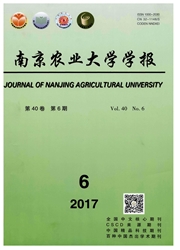

 中文摘要:
中文摘要:
[目的]本文的目的是深入了解杀菌剂氯苯嘧啶醇施用对草地早熟禾(Poa pratensis L.)夏季草坪斑枯病病菌及根际土壤真菌的影响。[方法]根据真菌内转录间隔区(ITS)基因的种内相对保守和种间差异比较明显的特点,使用Illumina高通量测序技术对氯苯嘧啶醇喷施后草地早熟禾根际土壤微生物宏基因组进行高通量测序。[结果]对照和氯苯嘧啶醇喷施处理的根际土壤分别产生4 851 438和3 037 924条Illumina双末端测序序列,经质量控制与序列比对后分别产生28 219和21 288个代表操作分类单位(OTU)。与对照相比,氯苯嘧啶醇施用后草地早熟禾根际土壤中子囊菌门真菌(Ascomycota)比例减少了18%,而担子菌门真菌(Basidiomycota)增加了32%,壶菌门类真菌(Chytridiomycota)和球囊菌门真菌(Glomeromycota)相对比例无显著变化;草地早熟禾根际土壤中真菌在科的分类单位上减少7个,在属的水平上减少152个,在种的水平上减少200个真菌种(类)。[结论]氯苯嘧啶醇喷施后不仅对草地早熟禾根际土壤中夏季草坪斑枯病致病菌有较强的抑制作用,而且对草地早熟禾根际土壤中疱霉属(Phoma)、小球腔菌属(Leptosphaeria)、镰刀菌属(Fusarium)和瓶霉属(Phialophora)土壤优势真菌有明显抑制作用。
 英文摘要:
英文摘要:
[ Objectives] The objective of this study was to get deeper insight in the effect of fenarimol application on Magnaporthe poae and fungi properties in the M. poae infected soil. [ Methods ] Based on the 18s rRNA internal transcribed spacer(ITS) gene, two metagenomic libraries from control and fenarimol treated rhizosphere soil were constructed, and deeper sequencing was carried out by Illumina Genome Analyzer( GA)technology. [ Results] There were 4 851 438 and 3 037 924 Illumina reads generated from control and fenarimol treated rhizosphere soil samples, which were further clusterd to 28 219 and 2l 288 repetitive operational taxonomic unit (OTU). After fenarimol treated, Ascomycota decreased 18% compared with the control, while Basidiomycota increased 32%, and there were no significant changes of Chytridiomycota and Glomeromycot. In addition, there were 7 phyla, 152 genera and 200 fungi species that disappeared after fungicide application. [ Conclusions ] Fenarimol had significant suppression on M. poae and Phoma, Leptosphaeria, Fusariuma, Phialophora communities in rhizosphere soil.
 同期刊论文项目
同期刊论文项目
 同项目期刊论文
同项目期刊论文
 期刊信息
期刊信息
